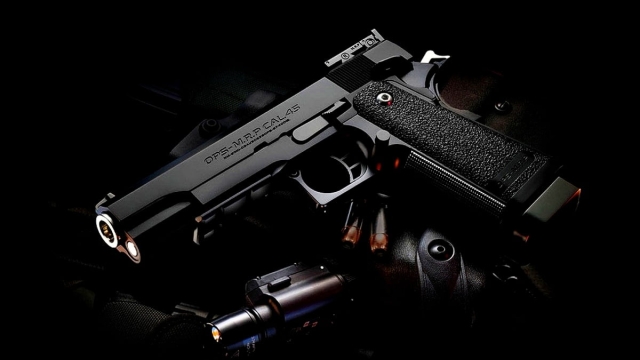Firearms have played a significant role in shaping the world we live in today. These powerful tools have had a profound impact on history, politics, and even the way we perceive personal security. From ancient times to the modern era, firearms have evolved and progressed, becoming intricate works of art that combine engineering prowess, functionality, and aesthetics. In this article, we delve into the fascinating realm of firearms, exploring their history, technology, and cultural significance, taking a closer look at how these pieces of machinery have shaped and continue to shape our world. So, fasten your seatbelts as we embark on a journey into the art of firepower.
Types of Firearms
Handguns
Handguns are compact firearms designed to be held and operated with one hand. They are commonly used for self-defense, law enforcement, and sport shooting. Handguns come in various types, including pistols and revolvers. Pistols are semi-automatic firearms that use a magazine to hold rounds of ammunition, while revolvers have a rotating cylinder that holds the ammunition. Handguns are valued for their portability and versatility in a wide range of situations.
Rifles
Rifles are long-barreled firearms that are fired from the shoulder. They are highly accurate and have a longer effective range compared to handguns. Rifles are widely used for hunting, sport shooting, and military applications. There are different types of rifles, such as bolt-action, semi-automatic, and fully automatic. Bolt-action rifles require manual cycling of the bolt to chamber each round, while semi-automatic rifles automatically load a new round after each shot. Fully automatic rifles can continuously fire as long as the trigger is held down.
Shotguns
Shotguns are firearms that are designed to fire multiple projectiles, typically in the form of shells filled with shot or slugs. Shotguns are commonly used for hunting, sport shooting, and home defense. They have a smooth bore barrel or a rifled barrel, with the latter providing improved accuracy when firing slugs. Shotguns can also come in different action types, including pump-action, break-action, and semi-automatic. Pump-action shotguns require manual cycling of the action to chamber a round, while break-action shotguns have a hinge that allows the barrel(s) to be opened for reloading. Semi-automatic shotguns automatically load a new round after each shot.
History of Firearms
The origins of firearms can be traced back several centuries, with the invention of gunpowder in China during the 9th century. This revolutionary development paved the way for the creation of various types of firearms, forever changing the art of warfare and hunting. As civilizations advanced, so did the evolution of firearms.
Early firearms were cumbersome and unwieldy. They consisted of simple smoothbore tubes known as "hand cannons" which required a long match to ignite the gunpowder. These early prototypes were not accurately aimed and lacked the ability to project projectiles with precision. However, they soon became an integral part of warfare during the late medieval period.
During the 15th and 16th centuries, advancements in weaponry led to the advent of matchlock firearms. These muskets featured a mechanism that held a lit match to the powder charge, providing a more reliable and efficient means of igniting the gunpowder. The matchlock muskets played a crucial role in shaping military tactics and strategies, significantly impacting the outcomes of battles.
The next significant development in firearm history came with the introduction of the flintlock mechanism in the 17th century. This innovative technology utilized a flint striking against steel to create sparks, igniting a priming charge and subsequently firing the weapon. Flintlock firearms were more reliable, quicker to reload, and had better accuracy compared to their predecessors. This advancement fueled the popularity and widespread use of firearms across various cultures and armies.
The history of firearms is a testament to mankind’s ingenuity and the continuous pursuit of more efficient and effective means of projecting force. From the basic hand cannons to the intricate mechanisms of the flintlock muskets, each innovation has played a vital role in shaping the world we live in today. As we delve further into the world of firearms, we will explore the remarkable advancements achieved in recent centuries and their impact on our modern society.
Firearms Safety
Firearms safety is of utmost importance when it comes to owning or handling firearms. Being aware of the proper safety measures can help prevent accidents and ensure a responsible approach to firearm use. Here are three essential aspects of firearms safety:
- Adhering to the Four Fundamental Rules: The Four Fundamental Rules of firearm safety serve as the foundation for responsible gun ownership. They are as follows:
- Always treat firearms as if they are loaded: This means that even if you believe a firearm to be unloaded, you should still handle it with the utmost care and precaution.
- Never point the muzzle at anything you are not willing to destroy: Keeping the muzzle pointed in a safe direction is crucial to avoid unintentional harm or damage.
- Keep your finger off the trigger until your sights are on the target: By keeping your finger away from the trigger until you are ready to shoot, you minimize the chances of an accidental discharge.
- Be aware of your target and what lies beyond it: Understanding what is in your line of fire and what could be affected by a potential discharge is essential for safety.
-
Proper Storage and Locking: Firearms should always be stored securely to prevent unauthorized access, particularly in homes with children or individuals who are not trained in firearm use. It is advisable to use locked storage cases or safes to ensure firearms are inaccessible to unauthorized individuals.
-
Training and Ongoing Education: Proper training is crucial for anyone handling firearms. Basic knowledge of firearm safety, handling, and operation should be obtained through certified courses. Ongoing education helps gun owners stay updated on the latest safety practices, reinforcing good habits and preventing complacency.
Remember, firearms safety is a responsibility that should never be taken lightly. By adhering to these principles and continually educating oneself, individuals can enjoy the world of firearms in a safe and responsible manner.






